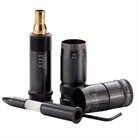The normal process that happens when a cartridge is fired is for the primer to move to the rear and unseat itself as the pressures begin to rise, as the pressure begins to increase the case expands radially and sticks to the chamber walls, then the case starts to stretch in both directions. The head will stretch until it contacts the bolt face, re-seating the primer as it does. If the pressure never reaches the proper level then the head wont stretch enough to re-seat the primer.
Right on. If I were OP, I would look at the headspace on the cartridges if "backout" is sufficient to be worrisome, but IMO, .001-.002 is not. When fired, as stated above, primer is driven back against bolt face, then case expands to fill the available space reseating spent primer. The more headspace, the farther primer is pushed back. If HS is excessive, due to chamber or if shoulder has been pushed back a bit too far, primer can be pushed back farther, with enough force to create a "top hat" like bulge at unsupported ogive of the primer.
I suspect the primers that were pushed back were result of slight headspace differences. Slight difference in headspace can be results of differences in "springback" from one case to the next as case is extracted from sizing die, even in same lot of brass or possibly due to the number of times ea. case has been fired.
To prove my theory, I checked headspace and primer backout of a number of FA 60 Match M72 cases fired in a Win. Mod 70 Match rifle w/snug chamber. Believe the primer backout to be directly related to the slight variations in headspace from one case to the next as measured with a Mo's cartridge headspace micrometer.
Once fired case headspace.................primer pushed out
.002----------------------------------------------.008"
.0025"...(2 cases)----------------------------.009 & .010"
Had one only case from same lot of brass that had been fired in above mentioned rifle, reloaded and fired again in same rifle (resulting in fireformed case). I push shoulder back .001 to .002" on fired brass when reloading for this rifle.
Reloaded fired case headspace............primer pushed out
.005"----------------------------------------------.0000 to .005" (My caliper is slightly off zero so probably zero backout)
I randomly checked several different caliber cases, all handloads, fired in both gas (G) and bolt (B) guns and found all had some primer movement:
308 W (B) .003 to .005" (Just under max listed load)
338 WM (B) .002--.003" (These were loaded on warm side)
375 h&h (B) .001'
.223 (G) .001-.002"* (Warm load)
243 WSSM (G) .003-.004"*
* Both rifles were AR's which unlock bolt before pressure subsides in bbl.
(No cases showed any signs of gas leakage)
As for OP's loads, shooting Garands for years in competition, I found 47 gr. H4895 to use same sight settings as
either M2 ball or M72 Match ammo originally issued for the Garand. (Takes a tad more IMR according to Sierra Manual but 46.3 gr of IMR = 2700 fps and 48.1 yields 2800.)
M2 Ball listed at 2740 fps and M72 @ 2640.
A new cartridge was developed in 1938 that was essentially a duplicate of the old M1906 round, but loaded with
IMR 4895 propellant and a new flat-based bullet that had a gilding metal jacket and a different lead alloy, and weighed 152 grains (9.8 g) instead of 150 grains (9.7 g). This 1938 pattern cartridge, the
Cartridge, Caliber .30, Ball, M2 achieved a muzzle velocity of 2,805 ft/s (855 m/s) and muzzle energy of 2,656 ft·lbf (3,601 J).
[15] Its maximum range was approximately 3,450 yd (3,150 m).
[16]
In 1938, the unstained, 9.8 grams (151 gr), flat-base bullet combined with the .30-06 case became the M2 ball cartridge.
The M2 Ball specifications required 2,740 feet per second (840 m/s) minimum velocity, measured 78 feet (24 m) from the muzzle.
[19] M2 Ball was the standard-issue ammunition for military rifles and machine guns until it was replaced by the 7.62×51mm NATO round in 1954.
OP might try neck sizing a few cases fired in his rifle; I'd bet the primers stay put.

Regards,
hm





